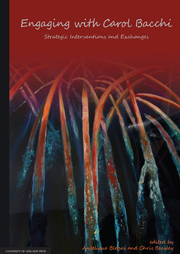Book contents
- Frontmatter
- Contents
- Acknowledgements
- List of Contributors
- Introduction
- Part I Looking back: On beginning
- Part II Strategic interventions and exchanges: Reflections and applications of the ‘What's the Problem Represented to be?’ approach
- 2 Introducing the ‘What's the Problem Represented to be?’ approach
- 3 Women, Policy and Politics: Recasting policy studies
- 4 Spaces between: Elaborating the theoretical underpinnings of the ‘WPR’ approach and its significance for contemporary scholarship
- 5 Digging deeper: The challenge of problematising ‘inclusive development’ and ‘disability mainstreaming’
- 6 Answering Bacchi: A conversation about the work and impact of Carol Bacchi in teaching, research and practice in public health
- 7 Located subjects: The daily lives of policy workers
- Additional interventions: Select reading list
- Part III Strategic exchanges: The wider context
- Part IV Looking forward: Still engaged
2 - Introducing the ‘What's the Problem Represented to be?’ approach
from Part II - Strategic interventions and exchanges: Reflections and applications of the ‘What's the Problem Represented to be?’ approach
Published online by Cambridge University Press: 05 June 2013
- Frontmatter
- Contents
- Acknowledgements
- List of Contributors
- Introduction
- Part I Looking back: On beginning
- Part II Strategic interventions and exchanges: Reflections and applications of the ‘What's the Problem Represented to be?’ approach
- 2 Introducing the ‘What's the Problem Represented to be?’ approach
- 3 Women, Policy and Politics: Recasting policy studies
- 4 Spaces between: Elaborating the theoretical underpinnings of the ‘WPR’ approach and its significance for contemporary scholarship
- 5 Digging deeper: The challenge of problematising ‘inclusive development’ and ‘disability mainstreaming’
- 6 Answering Bacchi: A conversation about the work and impact of Carol Bacchi in teaching, research and practice in public health
- 7 Located subjects: The daily lives of policy workers
- Additional interventions: Select reading list
- Part III Strategic exchanges: The wider context
- Part IV Looking forward: Still engaged
Summary
The ‘WPR’ approach is a resource, or tool, intended to facilitate critical interrogation of public policies. It starts from the premise that what one proposes to do about something reveals what one thinks is problematic (needs to change). Following this thinking, policies and policy proposals contain implicit representations of what is considered to be the ‘problem’ (‘problem representations’). For example, if forms of training are recommended to improve women's status and promotion opportunities, the implication is that their lack of training is the ‘problem’, responsible for ‘holding them back’. The task in a ‘WPR’ analysis is to read policies with an eye to discerning how the ‘problem’ is represented within them and to subject this problem representation to critical scrutiny. This task is accomplished through a set of six questions and an accompanying undertaking to apply the questions to one's own proposals for change:
What's the ‘problem’ (for example, of ‘problem gamblers’, ‘drug use/abuse’, ‘gender inequality’, ‘domestic violence’, ‘global warming’, ‘sexual harassment’, etc.) represented to be in a specific policy or policy proposal?
What presuppositions or assumptions underpin this representation of the ‘problem’?
How has this representation of the ‘problem’ come about?
What is left unproblematic in this problem representation? Where are the silences? Can the ‘problem’ be thought about differently?
What effects are produced by this representation of the ‘problem’?
How/where has this representation of the ‘problem’ been produced, disseminated and defended? How has it been (or could it be) questioned, disrupted and replaced?
- Type
- Chapter
- Information
- Engaging with Carol BacchiStrategic Interventions and Exchanges, pp. 21 - 24Publisher: The University of Adelaide PressPrint publication year: 2012
- 142
- Cited by

